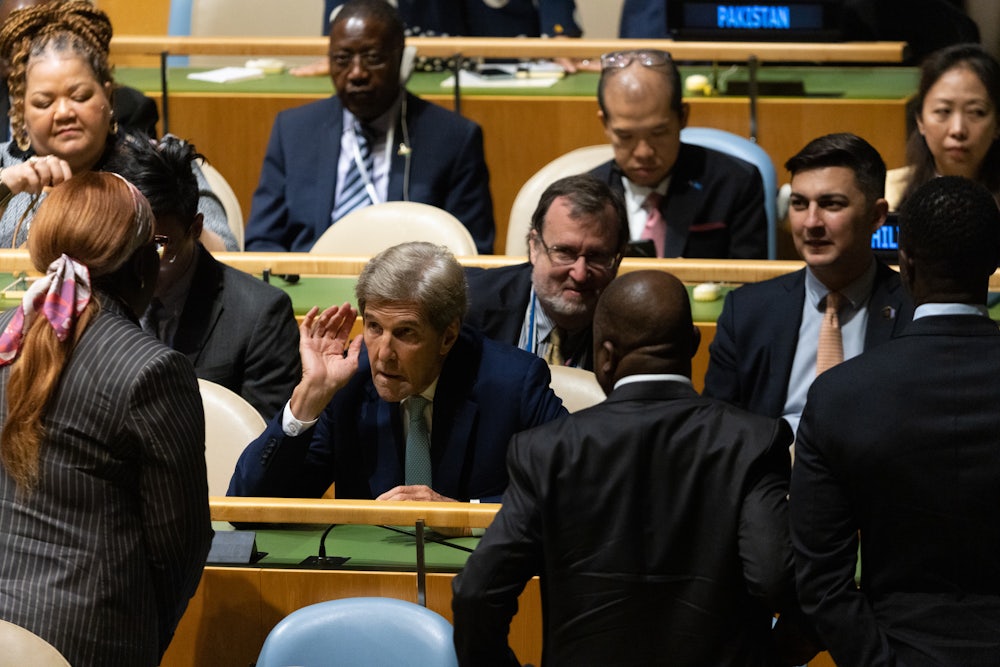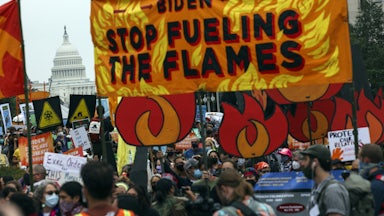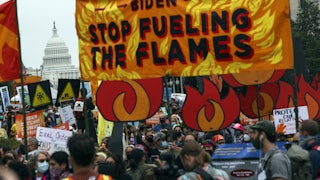At the COP27 climate conference, reparations are on the agenda. This exact term is rarely used—when Pakistani climate minister Sherri Rehman called for “reparations” in the wake of the terrible floods that swallowed up much of her country this summer, she was breaking with convention. The climate community typically speaks of “loss and damage,” a euphemism referring to financial compensation for the lives already lost and the homes already damaged. Developing countries expect loss and damage funding to be delivered separately from the much needed funding for mitigation (cutting emissions) and adaptation (building seawalls and planting mangroves, for example).
Rich countries including the United States, who bear disproportionate responsibility for climate change, have typically rejected reparations as radical, unrealistic, or a divisive distraction. But as the many instances of reparations throughout history show, paying reparations always sounds unrealistic until it isn’t. And there is more to reparations than handing over money and considering the matter settled.
Going by the classic Oxford English Dictionary definition, wherein reparations consist of “making of amends for a wrong one has done, by paying money to or otherwise helping those who have been wronged,” the U.S. in fact has a rich reparations tradition. U.S. history is full of cases where the government paid reparations to its own citizens—even dating back to the colonial period. In 1725 the Massachusetts state legislature paid 20 pounds each to the families of the victims of the Salem witch trials. In the latter half of the twentieth century, the U.S. federal government paid over $800 million to Native American tribes whose land had been taken by force or deception, and about $1.6 billion to Japanese Americans who were wrongly detained in camps during World War II, as well as $117 million to people exposed to radiation from nuclear tests.
Notably absent from a list of U.S. reparations are payments to enslaved people or their descendants, although the issue did gain some traction, including hearings in Congress, after Ta-Nehisi Coates’s writings on the topic in the mid-2010s. (South Africa, for its part, did pay $85 million to victims of apartheid and racist injustice in 2003.) Instead, the people who received payments over slavery were the slaveowners: Those who stayed loyal to the Union during the Civil War received compensation for their “lost property,” i.e., the freeing of enslaved persons. (This is somewhat reminiscent of the compensation fossil fuel firms are entitled to under investor-state dispute settlement agreements like the Energy Charter Treaty, which stipulates that companies whose investments—say, a drilling well—are rendered unprofitable by government policies—for example, lifesaving emissions reductions targets—are entitled to compensation. The ECT recently forced Italy to pay over $190 million to compensate the British firm Rockefeller for Italian policy changes that reduced future oil and gas profits.)
Reparations that involve transfers of value from one country to another are more relevant for the climate case. The idea behind calls for loss and damage funding is that the countries that have done most to pollute the atmosphere, and grown rich doing so, should compensate, per U.N. language, “developing countries that are particularly vulnerable to the adverse effects of climate change.” In other words, countries like the U.S., France, and Japan should pay countries like Brazil, Indonesia, or small island states like Kiribati that will literally disappear beneath the waves.
These sorts of international reparations also have historical precedent. Most frequently, they’ve been imposed by victors upon their enemies after wars—from the draconian peace terms that Rome forced on Carthage in the second century BCE, to the giant bill that the Allies handed Germany at the Paris Peace Conference of 1919.
But countries have also voluntarily paid reparations to atone for crimes. In 1952, West Germany agreed to pay the new state of Israel 3.45 billion German marks in view of the “unspeakable criminal acts committed against the Jewish people during the Nationalist-Socialist Reign of terror.” Then in 2021, Germany formally apologized to Namibia for the genocide Germans committed during their colonial regime there between 1904 to 1908, and agreed to provide a grant of 1.1 billion euros. Interestingly, the payment was not framed as reparations for colonial-era crimes but rather as funding for projects to promote remembrance and reconciliation.
Reparations for colonial crimes might be the closest analogue to climate reparations, given the eerily similar power dynamics—not to mention the role colonialism played in the industrialization that fueled the climate crisis. The Germany-Namibia deal is unusual: While the king of Belgium has recently expressed his “deepest regrets for the wounds of the past” to the Democratic Republic of the Congo’s parliament, the Belgian government has not sent any money, to the dismay of leading Congolese politicians. Instead, Belgium is returning a small share of the valuable Congolese art pieces that Belgians illegally took home over the years.
Belgium’s art returns are a form of nonmonetary reparations, belonging to a category also including formal apologies or the provision of benefits, like Spain’s program to offer citizenship to the descendants of the Sephardic Jews expelled during the fifteenth-century Spanish Inquisition. The Glasgow Dialogue on loss and damage established at the last COP does discuss some nonmonetary reparations, such as reskilling programs or early warning systems for weather events. Yet the big prize is clearly money—that’s why developing country representatives in Glasgow pushed in vain for a financing facility rather than a dialogue.
Advocates for climate reparations face some of the same moral and practical challenges that have bedeviled these previous reparation debates. First, how do you put a price on monumental human suffering? During the debate on German reparations to Israel, many Israelis marched in front of the Knesset to oppose accepting German “blood money.” Many may similarly feel that no amount of money can properly compensate for rising waters swallowing their ancestral homeland.
The second problem involves resistance and resentment. U.S. climate envoy John Kerry alluded to this in a recent outburst explaining why loss and damage financing was politically impossible: “You think this Republican Congress where we couldn’t get one vote for [the recent U.S. climate bill] is going to step up and do loss and damage? Good luck!” A Florida homeowner who lost their home to a flood may not accept that their tax dollars should go to Pakistani flood victims to compensate for U.S. carbon emissions.
Then comes the distribution issue: What kind of formula could fairly allocate a monetary transfer from one half of the global economy to the other, and how would governments divide it up once it arrived?
And finally, rich countries worry about how to close the door once it’s been opened. Would reparations that seem to indicate guilt expose them to gigantic legal liabilities for damage on a planetary scale? Studies estimate, after all, that annual loss and damage finance needs in developing countries will be between $200 to $580 billion a year by 2030. Yet the safeguards rich countries have already imposed would also limit that liability: Developed countries added a clause to the Paris Agreement to clarify that the article on loss and damage “does not involve or provide a basis for any liability or compensation”.
Climate reparations must also overcome hurdles that have not applied in past instances. For one, the crime is not only ongoing but accelerating—more than half of all carbon dioxide emissions have occurred since 1990. For another, the guilty and the wronged can switch places: By some point in the late 2020s, China will have emitted more greenhouse gases than the EU countries ever have. Yet for the purposes of U.N. climate talks, China is officially a developing country that would be a recipient of loss and damage funds. And there’s a serious first mover problem: Would EU countries agree to hand over large sums for loss and damage if Canada or the U.S. refused to budge? Denmark recently became the first rich country to make a substantial loss and damage pledge—$13 million. But that’s still minuscule in the context of these talks.
So are negotiations on loss and damage at the upcoming U.N. climate talks hopeless? If the only metric is how much the global south agrees to pay amid high inflation, slow growth, and an energy crisis, then yes. The loss and damage talks in Sharm-al-Sheikh at COP27 will be acrimonious; the funding will be minimal.
But if one takes a more expansive view of what reparations are, there can be progress. In his book Reconsidering Reparations, the philosopher Olúfẹ́mi O. Táíwò argues for seeing reparations as part of a broader effort, “one central to the expansive project of building a more just world, not just as a material or symbolic mechanism of redress for past harms.”
Reparations, seen this way, are one part of building institutions that make people’s lives better, whether the crime is racial injustice or climate damage. In this view, monetary compensation is not the only part of reparations that matters. Any successful reparations effort, the legal scholar Maxine Burkett has written, “must contain three critical elements: an apology, a monetary or other award that gives actual or symbolic weight to that apology, and, most importantly, a commitment by the perpetrator not to repeat the offending act.” The fact that rich countries have not awarded significant funds for loss and damage is perhaps understandable; but rich countries ducking responsibility for climate change and failing to anchor their climate pledges in domestic legislation is increasingly indefensible.
If rich Western countries harbor any claims to moral leadership on climate policy, they have to do better than their officials’ current dismissive rhetoric on loss and damage, as exemplified by John Kerry’s remarks in September. They must at least consider formal apologies and meet unmet pledges for adaptation and mitigation funding. And as for loss and damages payment, the least they could do is make concrete offers for nonmonetary reparations of the sort that the Caricom Caribbean Community has requested of their former European colonizers, which in the climate case could include setting up cultural institutions to preserve memories of cultures threatened by climate change. Offering residence permits to citizens of small island states that will one day be lost to the sea would be another good place to start.
Reparations aren’t radical, and they aren’t without precedent. COP27 will not deliver reparations commensurate to the offense, or in line with potential recipients’ demands. But, as with climate mitigation, it is better to take some step forward, however small, than to stonewall. Better to push for a bike lane on your street or pass an imperfect bill through Congress than to stick one’s head in the sand. Better to set up a reparations commission or offer some symbolic small-scale funding than to pretend that reparations are inconceivable.










